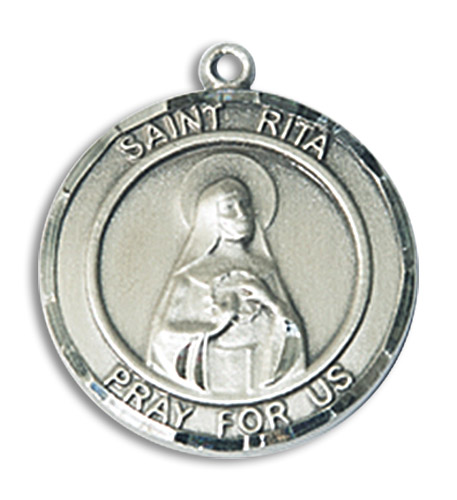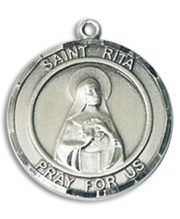$69.95 – $849.00
St. Rita Of Cascia Medal
- St. Rita of Cascia is the patron saint of impossible causes, difficult marriages, and parenthood.
- St. Rita of Cascia’s feast day is celebrated on May 22nd.
This St. Rita Of Cascia medal has been proudly hand-made for over a century by Bliss’ team of artists in Rhode Island. The St. Rita Of Cascia medal is crafted to last a lifetime.
St. Rita Of Cascia Medal
This St. Rita Of Cascia Medal and Necklace features a pendant with a hand pressed image of St. Rita of Cascia surrounded by the words ‘St. Rita Of Cascia Pray for Us’.
Sterling Silver St. Rita Of Cascia Medal and Necklace
14KT Gold Filled St. Rita Of Cascia Medal and Necklace
14KT Gold St Rita Of Cascia Medal
ST. RITA
Early life
Saint Rita of Cascia, “the advocate of the hopeless” was born on May 22, 1381 at Rocca Porrena, a town about two miles from Cascia. Her parents, Antonio and Amata Mancina, were called the “Peacemakers of Christ” for their successful efforts in reconciling enemies and settling disputes. St. Rita was baptized in the Church of Santa Maria in Cascia four days after her birth. When she was brought home and laid in her cradle, and fast asleep, a swarm of bees surrounded her and entered her mouth. Miraculously, she was not injured.
Life of Marriage
As Saint Rita grew up, she desired a life of union with God, so her parents fitted up a little room in their home as an oratory, where she spent all her spare moments. At the age of twelve, however, she desired to devout herself to God as a nun. Though her parents were pious, they pleaded St. Rita to postpone her noble purpose prevailed on Rita, and they gave her in marriage, at the age of eighteen, to an impulsive, short-tempered young man, who tested St. Ritas patience and virtue. St. Rita bore two sons, each inheriting their father’s irritable temperament. Rita continued her accustomed devotions, and her sanctity and prayers finally won her husband’s heart so that he willingly consented that she continue her acts of devotion.
Becoming a nun
Eighteen years into her marriage, St. Ritas husband was murdered by an old enemy. Both of her sons died shortly after. Rita’s desire to consecrate herself to God again took possession of her. Three times, she sought admittance among the Augustinian Nuns in Cascia, but her request was refused each time, and she returned to her home in Roccaporena. God Himself, however, supported her cause. One night as Rita was praying earnestly in her humble home, she heard herself called by name, while someone knocked at the door. In a miraculous way, she was led through the entrance of the monetary, though no door had been opened. Astonished at the miracle, the Nuns received Rita, and soon enrolled her among their number.
The thorn
St. Rita’s hidden, simple life in religion was distinguished by obedience and charity; she performed many extreme penances. After hearing a sermon on the Passion of Christ, she returned to her room; kneeling before her crucifix, she implored: “Let me, my Jesus share in Thy suffering, at least of one of Thy thorns”. Her prayer was answered. Suddenly one of the thorns detached from the crucifix and fastened itself in her forehead so deeply that she could not remove it. The wound became worse, and gangrene set in. Because of the foul odor emanating from the wound, she was denied the companionship of the other Sisters; this continued for fifteen years. Miraculous power was soon recognized in St. Rita. When Pope Nicholas IV proclaimed a jubilee at Rome, Saint Rita desired to attend. Permission was granted on condition that her wound would be healed, and it her wound became healed. However, this only lasted for the duration of the trip. Upon her return to the monastery the wound from the thorn reappeared, and remained until her death.
Death
As St. Rita was dying, she requested a relative to bring her a rose from her old home at Rocca Porrena. Although it was not the season for roses, the relative went and found a rose in full bloom. For this reason roses are blessed in the Saint’s honor. After St. Rita’s death, in 1457, her face became beautifully radiant, and the odor from her wound transformed to be as fragrant as the roses she loved so much. The sweet odor spread through the convent and into the church, where it has continued ever since. Her body has remained incorrupt to this day; the face is beautiful and well preserved. When St. Rita died, her lowly room glowed with heavenly light, while the great bell of the monastery rang by itself. A relative with a paralyzed arm, upon touching the sacred remains, was cured. A carpenter, who had known the Saint, offered to make the coffin. Immediately, he recovered the use of his long stiffened hands. As one of the solemn acts of his Jubilee, Pope Leo XIII canonized St. Rita on the Feast of the Ascension, May 24, 1900.
St. Rita of Cascia Rosary
UPC: 822362891962
Brand: Bliss
| Metal Finishing | |
|---|---|
| Size |
Be the first to review “St. Rita Of Cascia Round Medal and Necklace” Cancel reply
You must be logged in to post a review.





Reviews
There are no reviews yet.